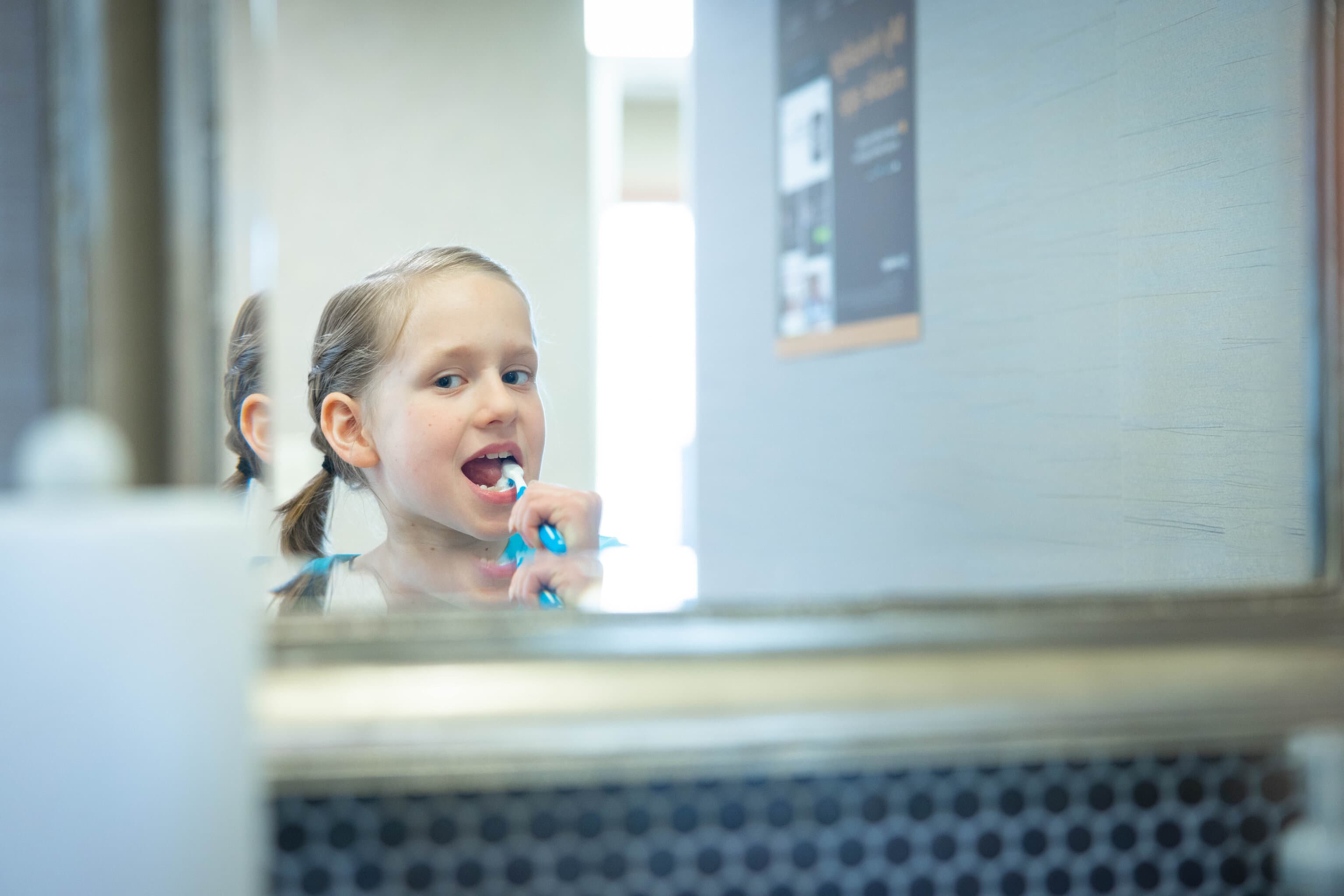Cleaning teeth with braces can be a challenge. How do you get around all those braces brackets and wires? Is there an easy way to floss with braces? We have a few tips for you!
Brushing and flossing with braces isn’t as difficult as it seems with the right tools. The Wilson & Hendrickson Orthodontics team will give you suggestions when you get your braces in Topeka, KS, but you may want to keep these tips handy. Great oral hygiene is important to your teeth and gums, especially while wearing braces!

Brushing With Braces
How to Brush Teeth With Braces
The best way to brush with braces is twice a day for two full minutes, and ideally after every meal. Food particles that get stuck in your braces can quickly lead to plaque buildup and enamel damage — so don’t skip those extra brushing sessions when you can.
If you’ve consumed acidic foods or drinks (such as soda or citrus), wait about 30 minutes before brushing to avoid damaging softened enamel.
Step-by-Step: Best Way to Brush With Braces
Use gentle, circular motions to clean around each bracket and along the gumline. Don’t forget the chewing surfaces and the tongue side of your teeth.
Pro tip: Try the three-pass method
- First pass: Brush straight across the brackets
- Second pass: Angle up toward the gumline
- Third pass: Angle down to clean under the brackets
This method ensures every surface is cleaned thoroughly.
Best Toothbrush for Braces
An electric toothbrush is often the most effective option for braces, thanks to its oscillating power and built-in timers. But a manual toothbrush can still work well if you use proper technique.
Best Toothpaste for Braces
Use a fluoride toothpaste to help strengthen enamel and fight cavities. Do not use whitening toothpaste with braces, as it can bleach the exposed enamel and leave darker squares where the brackets were after removal.
Avoid eating or drinking for 30 minutes after brushing to give the fluoride time to absorb and protect your teeth.
How to Floss With Braces
Flossing with braces is just as important as brushing. Without it, food and plaque can build up between teeth and along the gumline — areas a toothbrush simply can’t reach.
Step-by-Step: How to Floss With Braces
To use traditional floss, you’ll need a floss threader. It works like a sewing needle:
- Thread the floss through the loop
- Guide it under the archwire
- Floss gently between the teeth and under the gumline
Pull the floss through and repeat between every tooth
Best Flossing Tools for Braces
- Dental floss + floss threader: Most effective for deep cleaning
- Water flosser (like a Waterpik): Great for flushing debris, but less effective at plaque removal
- Interdental brush (proxabrush): Handy for quick cleaning around wires and between brackets
While these tools are helpful, traditional flossing once a day remains the gold standard for oral hygiene with braces.
Can You Use Mouthwash With Braces?
Yes — using mouthwash with braces can help reduce bacteria, prevent plaque buildup, and protect enamel, especially when brushing isn’t possible after meals.
How to Use Mouthwash With Braces
- Use fluoride mouthwash at least once daily
- Swish for at least 30 seconds to coat all tooth surfaces
- Wait 30 minutes after brushing to let the toothpaste’s fluoride absorb
- Avoid eating or drinking for 30 minutes after rinsing
- Don’t rinse with water after using mouthwash
Both fluoride and antiseptic mouthwashes are safe to use with braces — just be sure to follow timing guidelines for best results.
Braces Cleaning Routine Summary
Morning:
- Floss with a threader
- Brush with fluoride toothpaste
- Wait 30 minutes before eating, if possible
After meals/snacks:
- Brush if you can
- If not, rinse with water or mouthwash
Evening:
- Floss again if needed
- Brush with proper technique
- Use mouthwash before bed

Frequently Asked Questions: Brushing and Flossing With Braces
What’s the easiest way to floss with braces?
A floss threader lets you use regular floss by guiding it under your archwire. Water flossers and proxabrushes can help in between, but traditional flossing is still the most effective method for preventing cavities and gum issues.
Can I use mouthwash with braces?
Yes. Both fluoride and antiseptic mouthwashes are safe with braces. Just don’t rinse with water afterward, and avoid food or drinks for at least 30 minutes to let the fluoride absorb properly.
Why should I avoid whitening toothpaste with braces?
Whitening toothpaste only works on the visible enamel. If you use it while wearing braces, the areas under your brackets won’t whiten, leaving your teeth uneven in color when your braces come off.
Should I brush after every meal with braces?
Yes. Food can get trapped in brackets and wires, leading to plaque and decay. If you can’t brush after a meal, rinse your mouth with water or use mouthwash to keep things clean until your next full brushing.
Brushing and Flossing Help From Your Topeka Orthodontist
At Wilson & Hendrickson Orthodontics, we’re committed to helping every patient feel confident in their braces care routine. Whether you need help learning how to floss with braces, want brushing tips, or need a reminder on what toothpaste to use, we’re here to guide you every step of the way.
We serve patients of all ages throughout Topeka, KS, and the surrounding area with expert orthodontic care, including braces and Invisalign.
Do you have questions about cleaning your teeth with braces?
Schedule a free consultation or give us a call — we’re happy to walk you through everything you need for a cleaner, healthier smile during treatment.









